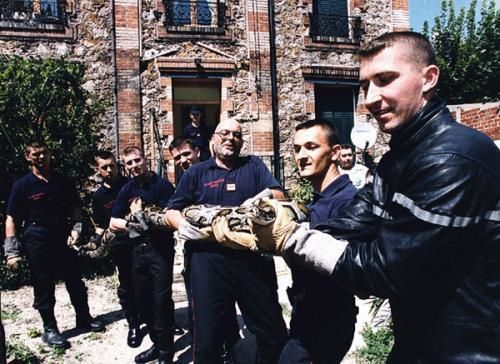(Text and pictures by Ruud Haak from the book "The search and rescue dog" by Dominique Grandjean)
Some of the here mentioned characteristics will develop during the training, and cannot be fully tested beforehand. The ability to cope with mistakes is such a
characteristic one cannot really test before, but it has proven to be very important in training and missions.
Search and rescue dog work is physically particularly intensive, but also requires very intensive mental work. The mental characteristics of a potentially good dog are:
Strength of character
The dog is behaving in a self-confident manner when his attitude is free of nervousness, fear or jumpiness. Sudden and unexpected prickles, like gunshots, noise by traffic, or
for instance waving flags, do not bring him out of balance.
Temperament
This is expressed in the psychological skills and the degree of reaction to different prickles from the environs. The more lively a dog is and more intensive his response to
his surroundings, the more full of temperament he is. It is important to recognize the difference between a dog full of temperament and a nervous dog.
 A dog
that likes to work shows a lot of interest when the handler is ready to go.
A dog
that likes to work shows a lot of interest when the handler is ready to go.
Willing to work
A dog that likes to work shows a lot of interest when he sees that you’re getting ready to go. The dog must also have the willingness to continue even if there is no immediate
reward.
Composure
This is a very important factor. An adult dog must stay absolutely calm and show self-confidence, even when placed in totally strange circumstances. He quietly has to overlook
the situation, neither afraid nor ranting and raving, whether among people, in a town, in the traffic or with events, the dog has to stay calm.
Intelligence
We distinguish between three forms of intelligence:
By instinctive intelligence we mean all hereditary skills and behaviour. For instance, the hunting drive: every puppy runs after a moving object.
By practical intelligence we mean the speed with which, and the degree to which, the dog conforms to the desires of the handler. Roughly said, how quickly and how
correctly the dog learns the different exercises.
Adaptive intelligence can be divided into two abilities: learning proficiency, which means how quickly the dog develops adequate
behaviour in a new situation, and the problem solving ability. This last is the dog’s skill to choose the correct behaviour to solve a problem he encounters.
 The dog
follows an odour whith its nose in the air, exhibiting enthousiasm and great determination
The dog
follows an odour whith its nose in the air, exhibiting enthousiasm and great determination
Good searching drive
By search drive we mean the dog’s interest in catching missing persons, not only by using his nose, but also with support of his eyes and ears, and in following the found odour
by air scenting, with a high nose, enthusiastically and in very determined way.
Toughness
By toughness we mean the ability to suffer unpleasant prickles or events, for instance pain, without being put off for even a moment, and to forget these just as quickly
(low sensitivity). Softness is the opposite of that (high sensitivity). Softness must not, however, be confused with fear of pain. There are dogs which are very sensitive to
pain and squeal at the littlest pain, for instance an injection. Fear of pain will not necessarily influence the dog’s willingness to work, because during the work you normally don’t recognize
it.
Courage
·This is the
characteristic of a dog that steps into dangerous situations without any pressure from outside, and stays there, even when this situation goes against his instinct for self-preservation.
Ability to cope with mistakes
If corrected (a verbal correction should be sufficient), the dog should remain composed, willing to work, and not loose its search drive. Dogs that cannot cope quickly with
being corrected are very difficult to work with.
 An
adult dog must stay absolutely calm and show self-confidence even in totally unfamiliar circumstances
An
adult dog must stay absolutely calm and show self-confidence even in totally unfamiliar circumstances
Question to Ruud Haak
Can an inadequate handler ruin a potentially good dog?
Indeed he can! On the other hand a good handler can go quite a long way with a not-so-good dog, but may be he will not be able to achieve the high standard necessary for
operational work. A handler must have a stable character and not be easily agitated by his dog’s behaviour. He must have learned to interpret the behaviour of different dogs, and be able to read
their signals quickly. He must have a lot of patience, be willing to review his own training critically, and go a step back in training regularly. He must be very aware of the possible pitfalls
he can come across in this work. He must realize that the dog is the only one who can smell well enough to solve the problem. He must never try to force his dog into ’making an alert’ but try to
adapt his training to manoeuver the dog into understanding what is expected of him. In short, he must be an intelligent and sensitive trainer. So, if you want to start, look at yourself
critically. Are you truly someone like this?



























/idata%2F0203239%2FMalte-2013%2FMalte-2013-6636.JPG)
/idata%2F0203239%2FIslande-2013%2FIslande-2013-5424.JPG)
/idata%2F0203239%2FSvalbard-2013%2FMagnifica-Spitz0582.JPG)
/idata%2F0203239%2FMolfsee-2013%2Fpopo048.JPG)
/idata%2F0203239%2FKeukenhof-2013%2FMSC2013Musica0912.JPG)
/idata%2F0203239%2FLondres-2013%2FLondres0413253.jpg)

